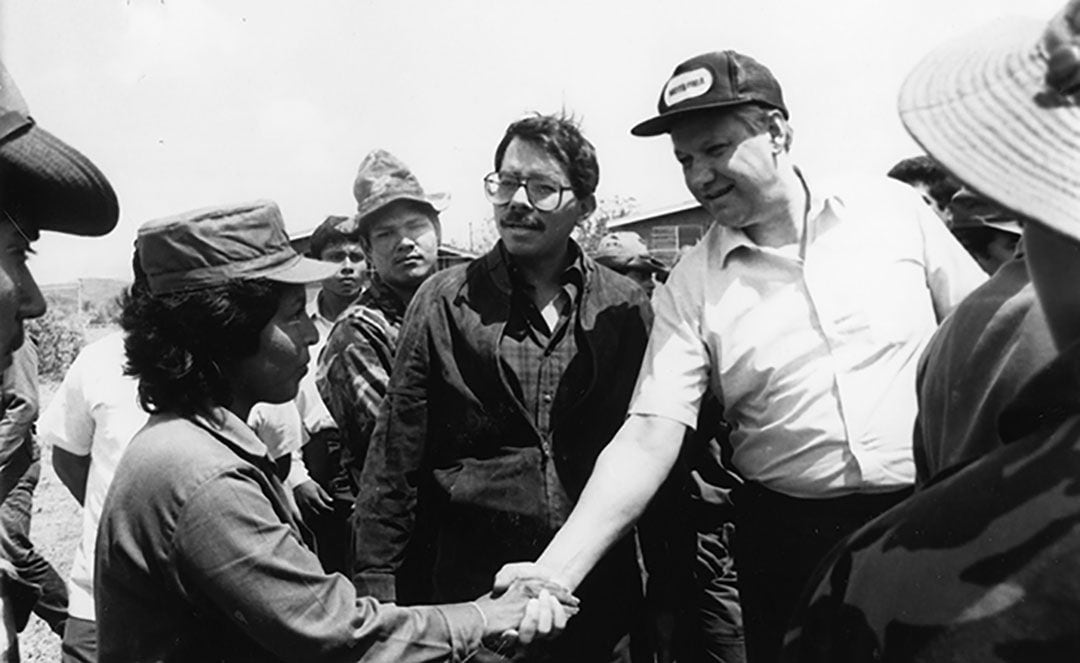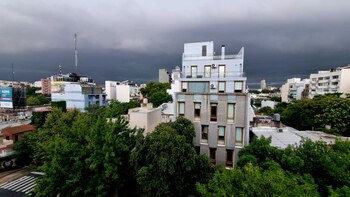
On March 3, 1987, Daniel Ortega recited to then-Russian MP Boris Yeltsin almost the same speech he repeats today before President Vladimir Putin. “The Soviets have invaded Nicaragua with their tractors, with their transport trucks, with their wheat and oil. If the United States wants the affection of the Nicaraguan people, let them behave like the Soviets,” he said on a farm in northern Nicaragua before the sullen gaze of the ruddy member of the Presidium of the Supreme Soviet, who only managed to fake a smile when the translation of flattery arrived.
It was all laughter and applause in the Sandinista ranks. However, that visit would mark the beginning of the end of their revolution. Soon after, Yeltsin would cease to be “Comrade Yeltsin”, and Commander Tomás Borge would even call him “insolent” and “counterrevolutionary”.
After Yeltsin's arrival, the Soviet Union would negotiate Nicaragua with the United States. Perestroika came, the end of the cold war, the fall of the Berlin Wall, the collapse of the Soviet Union and Daniel Ortega would lose the elections to a woman who campaigned in white and on crutches: Mrs. Violeta Barrios de Chamorro. With the end of the Sandinista revolution, the Russian presence in Nicaragua practically disappeared, and it would only return with Daniel Ortega when he returned to power in 2007.
Today the Sandinista regime is one of the few governments that support Russia in its invasion of Ukraine, despite the “betrayal” that the Soviets played against it at the end of the cold war, following Boris Yeltsin's visit to Nicaragua.

Millionaire support
Recently coming to power, the Sandinistas sought support in the defunct Union of Soviet Socialist Republics (USSR). In March 1980, a few months after the fall of the dictatorship of Anastasio Somoza, a high-level Nicaraguan delegation traveled to Moscow to seek economic and military assistance from the natural enemy of the United States, who until then had seen them with indifference. The delegation, led by Sandinista commanders Henry Ruiz, Humberto Ortega and Tomás Borge, signed a protocol of eight agreements, including a “plan of relations between the Communist Party (CPSU) and the Sandinista National Liberation Front (FSLN) of Nicaragua”.
There he began a relationship that would mark a decade in Nicaragua. The Sandinista People's Army (EPS) would fully arm itself with the best of the Soviet arsenal and Russian food oil and other countries in the socialist orbit would begin to arrive in the country to alleviate the growing shortages that were being suffered, as a result of war and mismanagement of government.
“The Soviets gave us state-of-the-art weaponry, which was still in the Warsaw treaty,” says retired major Roberto Samcam, who served as chief of staff of the artillery brigade Omar Torrijos. “Here arrived T-55 (war) tanks in navigable quantities, armored carriers, the BM21 (reactive missile battery) that were unthinkable from Panama to Mexico, howitzer guns 155, 130 and 120 millimeters and about two thousand portable missiles on the ground air Sam 7. Ultramodern weaponry for that time. And that gives you an idea of how confident they had in the revolution.”
The military man recalls that the United States offered a million dollars to the pilot who deserted and took a MI-24 war helicopter. “These helicopters were called flying tanks and they wreaked havoc in the counterrevolution until the gringos gave the contras the Stinger or Redeye missiles and that's where things leveled out.”
As Russian weapons and food arrived in Nicaragua, thousands of young people left for the Soviet Union to study different, and often strange, university careers. By 1990, the socialist countries of the East offered some 400 places to Nicaraguan scholarship holders.
Daniel Ortega keeps in a travel closet the pair of chapkas, those classic Russian leather hats, which he brought from his trip to Moscow in April 1985, where he arrived accompanied by his wife, Rosario Murillo, and Henry Ruiz, Minister of Cooperation and Trade. From that trip he also brought many matryoshka (Russian dolls) to give as gifts and a photograph with Mikhail Gorbachev, in which Ortega appears unusually laughing out loud, and which he keeps, or possibly kept, on a shelf in his house. And many plans for military and economic cooperation.
It is estimated that the Soviet Union spent a billion dollars a year to maintain Nicaragua, a country torn down by a civil war, which served as a scene of confrontation for world powers in the middle of the cold war.
Perestroika
Boris Yeltsin was the highest-ranking Soviet official who came to Nicaragua in the 1980s. His visit to Managua on March 2, 1987 was interpreted by the Sandinista board as an opportunity “to strengthen the relationship” with that powerful ally. The Sandinistas did everything to please the visitor, even though they thought he was a heavy and unpleasant guy.
“Surly and ill-mannered, no one liked him. He was, however, the highest level official who had ever visited us, and when in the Xiloá lagoon he decided to bathe completely naked, there were those among us who also ran to undress to keep him company. They had also assured us that Soviet support for the revolution would remain unchanged,” says the writer and former Sandinista leader, Sergio Ramírez in his memoir book Adiós Muchachos.

At some point Yeltsin suggested to the Sandinista commanders that they resign from government administration and Daniel Ortega reacted angrily, Ramírez says in an interview with the Spanish historian Maria Dolores Ferrero. “I remember the meeting at which Daniel Ortega asked him altered how he could recommend to the commanders that they move on to the retreat. Because what Boris Yeltsin was really telling you was: 'Get out of government, you don't know how to govern. '”
The Sandinista leadership seemed to be unaware of the scale of the changes that the world was undergoing, and after Yeltsin's visit they believed that Soviet support would continue “better than ever.” Shortly thereafter, however, an official of the Soviet Chancellery made things clear to them: they had to understand each other with the United States, end the war with the contras and seek financial support elsewhere. “They (Soviets) could no longer bear such a heavy burden. And we also had to stick to the mixed economy model to build trust,” wrote Sergio Ramírez.
At that time, the Soviet Union had secret talks with the United States and Nicaragua was a pawn to be sacrificed on the board. Negotiations then began between Sandinistas and contra guerrillas; the regime, relying on its popularity, decided to move the elections forward and open itself to international observation, and in February 1990, Daniel Ortega lost formal power to Doña Violeta Barrios de Chamarro. It was the end of the revolution.
The relationship between Nicaragua and the now Russian Federation almost disappeared. The approximately 400 scholarships for Nicaraguans in socialist countries available in 1990 would be reduced to 50 the following year. There was a debt of approximately three billion dollars left that would be forgiven or rescheduled in the next 15 years.
Approaches
With the return of Daniel Ortega to power in 2007, there was a dizzying approach to Russia, although no longer in the dimensions of the 80s. To please Russia, Ortega recognized independence to the separatist regions of Abkhazia and South Ossetia, and Russia has sent buses, taxi vehicles, wheat and set up a vaccine manufacturing plant that never got off the ground.
In 2016, 50 T72-B1 war tanks, four patrol boats, two 1241.8 Molnia rocket boats, and Yak-130 combat and training aircraft arrived in Nicaragua in 2016. A police training school and a controversial Russian satellite station were also set up in Managua for monitoring “natural disasters and combating drug trafficking”, but what security experts say is an espionage center “in the backyard of the United States”.

Daniel Ortega dusted off the chapkas he kept in his closet and in December 2008, as president, he visited Moscow again with his wife, Rosario Murillo, to “strengthen relations”. In fact, the Ortega Murillo family's visits to Russia have been constant over the years, with which they seek to build a similar relationship to that which Nicaragua had with the Soviet Union in the 1980s, to compensate for the international isolation suffered by its regime due to the dictatorial drift it had shown.
Nicaragua, along with Venezuela and Cuba, have supported the Russian invasion of Ukraine. The day before, Russian Deputy Prime Minister Yuri Borisov visited Managua, and soon after, Duma President Vyacheslav Volodin was in Nicaragua on the same day that Vladimir Putin ordered the invasion of Ukraine, as part of lobbying for allies in the war adventure.
Ortega is in danger of falling under the sentence of that saying “go for wool and get sheared,” says an analyst who asked for anonymity. “Support for Russia for political, military and economic support could be reversed because of the powerful sanctions with which much of the world is punishing Russia for the invasion of Ukraine and threats of nuclear war.”
The chairman of the Foreign Relations Committee of the United States Senate, Robert Menendez, warned that Latin American countries that support Russia in the aggression against Ukraine could “face its consequences,” among which would be the revision of the free trade agreement known as CAFTA.
“Again, Nicaragua could hang on the brush or become a negotiating piece between the great powers,” the expert calculates.
KEEP READING:
Últimas Noticias
Debanhi Escobar: they secured the motel where she was found lifeless in a cistern
Members of the Specialized Prosecutor's Office in Nuevo León secured the Nueva Castilla Motel as part of the investigations into the case

The oldest person in the world died at the age of 119
Kane Tanaka lived in Japan. She was born six months earlier than George Orwell, the same year that the Wright brothers first flew, and Marie Curie became the first woman to win a Nobel Prize

Macabre find in CDMX: they left a body bagged and tied in a taxi
The body was left in the back seats of the car. It was covered with black bags and tied with industrial tape
The eagles of America will face Manchester City in a duel of legends. Here are the details
The top Mexican football champion will play a match with Pep Guardiola's squad in the Lone Star Cup

Why is it good to bring dogs out to know the world when they are puppies
A so-called protection against the spread of diseases threatens the integral development of dogs




